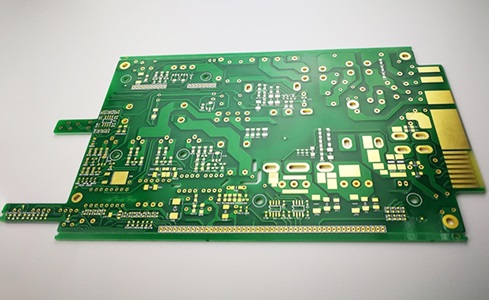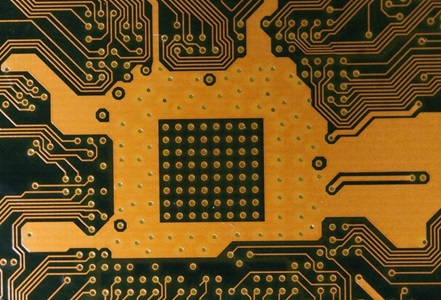In the realm of modern electronic products, the 4-layer FR4 PCB serves as an indispensable cornerstone. Crafted from FR4, a robust type of glass fiber renowned for its strength and exceptional electrical insulation properties, these PCBs play a pivotal role in the intricate landscape of electronic assembly. This article embarks on a journey through the assembly process of these complex and crucial components, offering a concise exploration of their fundamental concepts and the inherent advantages that make them a linchpin in the world of electronic manufacturing.
FR-4 material is one of the most common PCB substrate materials, widely used for its excellent properties. FR-4 exhibits good insulation performance, mechanical strength, thermal stability, and is cost-effective. Its exceptional electrical insulation allows it to withstand high voltages without damage, ensuring the integrity of electronic circuits. The material's robust mechanical strength enables it to endure bending and tensile stresses, contributing to the durability of electronic devices. FR4's versatility in thickness, compatibility with high temperatures during soldering processes, and low moisture absorption further enhance its suitability for diverse applications.
Designing a PCB with FR-4 material involves meticulous considerations to ensure optimal performance and manufacturability. The material specifications, including thickness and copper weight, must be clearly defined. Layer stackup configuration is crucial, taking into account signal routing, power planes, and ground planes. Emphasis on signal integrity is vital, necessitating the use of controlled impedance traces for high-speed signals. Thermal considerations require thoughtful placement of heat-generating components and the incorporation of thermal management strategies. Efficient component placement, robust power distribution, and careful routing adhering to trace width best practices contribute to the overall reliability of the design.
In the realm of PCB manufacturing, surface treatments play a pivotal role in both protecting the board and enhancing its solderability. Various treatments are available, with HASL and ENIG being notable examples. HASL involves coating the PCB with a layer of molten solder, providing a protective and solderable surface. ENIG, on the other hand, utilizes a thin layer of gold over a layer of nickel through a chemical process, offering excellent solderability and corrosion resistance.
Several factors influence the choice of surface treatment. The type of components used, assembly processes, and the operating environment are crucial considerations. For instance, ENIG is favored for its flat surface, making it suitable for fine-pitch components. HASL, being cost-effective, is commonly chosen for applications with less stringent requirements. The compatibility of surface treatments with lead-free soldering processes and the overall cost-effectiveness of the treatment method also influence decisions.

FR4, while widely used in PCB manufacturing, may not always meet the demands of high-speed or high-frequency applications due to limitations in heat management and signal integrity maintenance. In such cases, alternative materials like metal substrates emerge as more suitable options. Metal substrates, typically made of aluminum or copper, offer superior thermal performance and mechanical strength. Their robust thermal conductivity makes them ideal for dissipating heat generated by high-power electronics, ensuring reliable operation under demanding conditions. While FR4 remains a staple for many applications, the versatility and performance of alternative materials address the specific needs of high-speed and high-frequency electronic devices, offering designers greater flexibility in optimizing PCB designs for optimal performance and reliability.

The thermal and moisture resistance of PCBs are crucial for the reliability of electronic products, and the selection of suitable materials is paramount for these properties. In terms of heat resistance, commonly used materials such as FR4 exhibit excellent high-temperature performance, maintaining shape stability during component soldering to ensure circuit stability. Additionally, metal-based materials like aluminum and copper substrates perform well in high-temperature environments due to their outstanding thermal conductivity. In terms of moisture resistance, aside from the low moisture absorption of the aforementioned materials, there are special moisture-resistant substrates such as PTFE, known for its extremely low moisture absorption rate, making it suitable for applications sensitive to humid environments.
Therefore, in PCB design, selecting appropriate materials based on specific requirements and considering both thermal and moisture resistance contributes to ensuring the stable and reliable operation of electronic products in various conditions.
In the realm of electronic design, 4-layer FR4 PCBs stand out for their widespread use driven by cost-effectiveness and the combination of excellent thermal and electrical properties. However, their applicability encounters limitations, particularly in environments characterized by high temperatures and frequencies. The material selection, crucial for project success, hinges on meeting specific requirements. Despite the presence of alternative materials, the 4-layer FR4 PCB maintains its prominence in electronic design, appreciated for its low cost, reliability, and versatility. Looking ahead, advancements in FR4 materials or the introduction of new alternatives may offer enhanced performance for specific applications, reflecting the ongoing evolution of technology. For more detailed information, we welcome you to reach out to us.
By continuing to use the site you agree to our privacy policy Terms and Conditions.